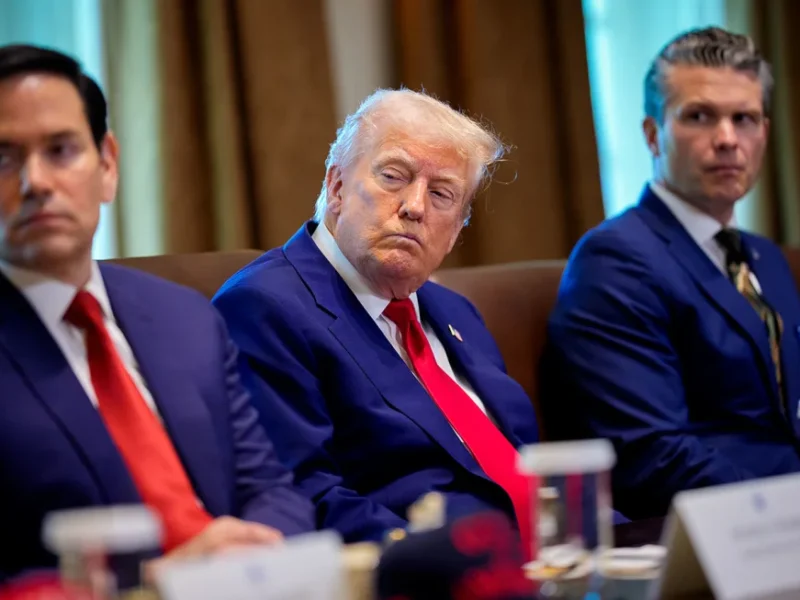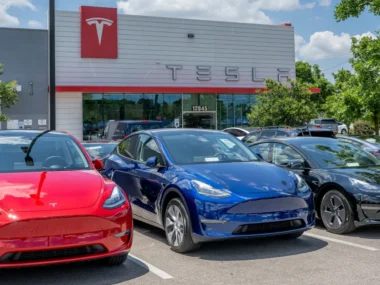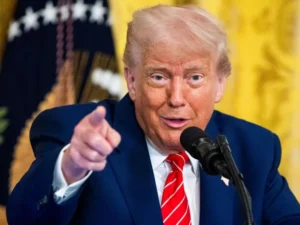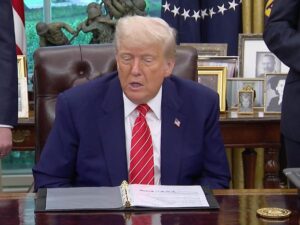In a matter of hours, Donald Trump shifted from praising America’s new “golden age” to warning parents that their children would have fewer toys, and those that were available would cost more.
This sudden change highlighted the contradiction between his “Make America wealthy again” rhetoric and the reality of the challenges that might accompany achieving such promises.
Trump’s rare moment of pessimism during a Cabinet meeting acknowledged that his trade war with China would lead to fewer goods and higher prices. It was a rare instance of truth amidst the optimistic narrative that often surrounds the White House.
This came after data released on Wednesday showed that the economy contracted by 0.3% in the first quarter—the first clear indication of how Trump’s policies are affecting U.S. economic growth.
The Commerce Department report doesn’t suggest an immediate crisis. Some of the data was more positive than the dip in GDP, and these reports are often revised as more information becomes available. Although the U.S. economy has been notably resilient, cycles of growth and contraction are a natural part of a capitalist economy.
The significance of this report lies more in its political impact than in its economic snapshot. Trump cannot afford for the negative data to become the prevailing narrative.
First, the report undermined the White House’s portrayal of Trump’s first 100 days as the most effective in history and highlighted his political vulnerabilities. While his tough stance on immigration has been a cornerstone of his support, his image as a skilled businessman driving economic success is key to his appeal. If that image fades, his political foundation weakens.
Second, the GDP report contributed to growing concerns about an economic downturn, signaling that rough times may be ahead. Trump cannot let this perception take hold, as it could erode his personal standing and lead to panic among Republican lawmakers, threatening the unity of the fragile GOP majority in the House. This unity is crucial for passing his ambitious tax and budget plans.
Most importantly, as signs emerge that consumers are already cutting back on spending, concerns about a potential recession could become self-fulfilling. History has shown that negative sentiment can drive a country into economic decline.
The international community is also watching. If Trump’s declining approval ratings signal political weakness, it could hurt his ability to negotiate favorable trade deals with other countries, especially as they seek to avoid his tariffs. If foreign leaders perceive him as desperate, they may be less inclined to offer good deals.

President Donald Trump, seated at the center left, listens during a Cabinet meeting at the White House on Wednesday, April 30, 2025, in Washington.
A Common Justification: It’s All Biden’s Fault.
As expected, Trump’s response tells the story.
After the GDP report was released, Trump posted a frantic message on Truth Social, stating, “This is Biden’s Stock Market, not Trump’s.” He added, “This will take a while, has NOTHING TO DO WITH TARIFFS.” Throughout the day, he blamed his predecessor to deflect responsibility for the economic data. Later, he pointed to future reports, claiming, “This is Biden, and you could even say the next quarter is sort of Biden because it doesn’t just happen on a daily or an hourly basis.”
Blaming the previous administration for poor economic news is a common political tactic. It’s true that it takes time for a new administration’s policies to take effect. Trump is responding to a real issue—the impact of globalization on industrialized communities across America.
However, his argument that economic setbacks are solely the fault of his predecessor would be more credible if he hadn’t launched a highly disruptive assault on the global economy and trade system, with little preparation, unclear metrics, and his trademark chaos.
When Trump stood in the White House Rose Garden with a scoreboard showing each country’s tariff rate, he took ownership of the economy. Many of the shocks and uncertainties currently affecting investors and consumers can be traced directly back to that moment.
Millions of Americans, especially those nearing retirement or recently retired, have seen the impact on their 401(k) pension plans. These months have been particularly unsettling for those dependent on their retirement savings.
A significant reason Trump won the 2024 election was that voters believed he had more viable solutions for reducing living costs, such as groceries. Despite his attempts to downplay the issue, he has done little to alleviate those costs, which significantly affect those who—unlike many of his Cabinet members—are not millionaires or billionaires.
Public perceptions have also been influenced by overwhelming evidence pointing to a struggling economy.
“This has probably been the least successful first 100 days of a presidency on the economy in history, in the last century,” said former Treasury Secretary Larry Summers to CNN’s Kate Bolduan. “We’ve seen the stock market decline significantly. The dollar has fallen. Unemployment forecasts are up. Inflation projections have increased. The likelihood of a recession has risen. Consumer confidence has collapsed. Businesses have withdrawn all their previous earnings forecasts.”
Top administration figures dismissed this grim outlook.
“This was the best negative GDP report I’ve ever seen in my life. It should really be positive news for America,” Trump’s trade advisor Peter Navarro told reporters. Trump, on the other hand, took credit for an increase in investment in the report—raising questions about why positive indicators were attributed to him while negative figures were blamed on Biden.
Other officials suggested that the Commerce Department numbers were skewed by a surge in imports, which suppressed growth. They argued that this gave a misleading impression of the economy’s health. However, the import surge occurred because companies were stockpiling goods, anticipating that Trump’s tariffs would disrupt trade. This indicates future economic issues rather than reflecting current strength.

President Donald Trump delivers remarks at an “Investing in America” event in Washington, DC, on April 30, 2025.
The Disparity Between Reality and Trump’s Promises.
The contrasting rhetoric and data emerging from the administration on Wednesday suggest that the White House faces a growing issue that will significantly shape Trump’s second term. Having propelled the US and global economies into uncertain territory based on his own instincts, Trump’s path to success is becoming increasingly unclear.
This is why his comment about the cost of toys was so telling. He was referring to the potential consequences of his confrontation with China, a key front in the trade war. Despite his claims of intense negotiations with Chinese President Xi Jinping, there is little public evidence of any meaningful talks. With the administration’s track record of misinformation, it’s difficult for observers to take these assertions seriously.
Trump, criticizing China as the “chief ripper-offer” of US jobs and factories, boasted that his actions had led to cargo ships filled with goods for the US to turn around and return to port, framing this as a positive development. He remarked, “Well, maybe the children will have two dolls instead of 30 dolls, and maybe the two dolls will cost a couple of bucks more than they would normally.”
Although the comment may have been offhand, it highlighted an underlying issue for the president. While it can be argued that the US has become overly dependent on inexpensive Chinese goods, the political ramifications of a billionaire president telling working parents they will be able to afford fewer toys for their children is starkly out of touch.
This problem extends beyond dolls. The flow of affordable consumer goods from China has harmed US manufacturing but has also raised the living standards of millions of Americans. From school supplies to clothes and electronics, nearly everyone has benefited from lower prices. If these goods become scarce, many families will experience significant hardship.
This was one of the few times Trump acknowledged the potential real-world consequences of his trade dispute with Beijing.
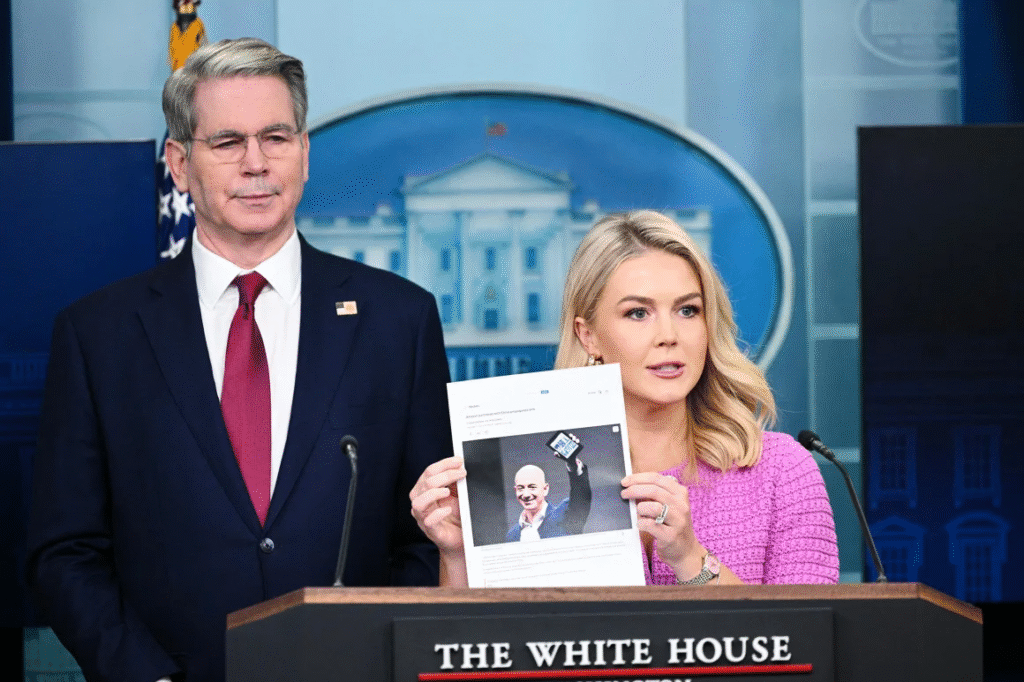
White House Press Secretary Karoline Leavitt, alongside Secretary of Treasury Scott Bessent, holds a news article about Amazon founder Jeff Bezos during the daily briefing in the Brady Briefing Room at the White House in Washington, DC, on April 29.
The White House continues to shield reality. On Tuesday, Press Secretary Karoline Leavitt criticized Amazon for allegedly planning to list the true cost of tariffs on its website, though the report was later denied.
A large portion of Trump’s day on Wednesday was spent attending events where Cabinet members and business figures showered him with praise.
“President, your first 100 days have far exceeded that of any other presidency in this country ever, ever. Never seen anything like it. Thank you,” Attorney General Pam Bondi said during a display of flattery at the Cabinet meeting. This isn’t the first time the White House’s messaging has seemed more focused on boosting the president’s morale than addressing the nation’s needs.
While some of this is comical, it highlights the fact that a president steering the economy and the world into uncertain waters isn’t receiving honest advice about the repercussions.
The disconnect between Trump’s perception and reality is likely to widen, which will undermine bold statements like the one he made in Michigan on Tuesday night: “Our Golden Age has only just begun.”

